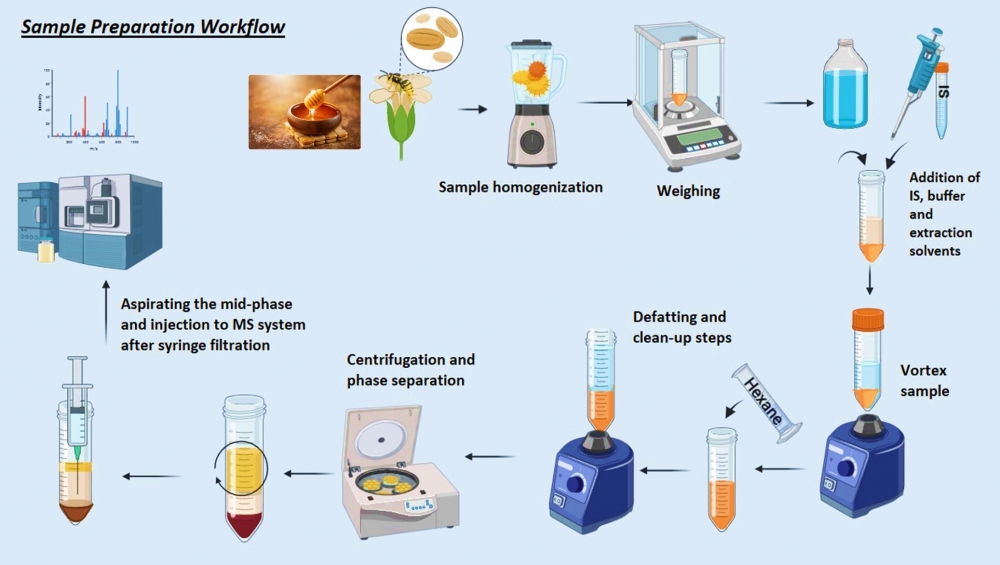JOURNAL 3059
Records of Agricultural and Food Chemistry
Year: 2024 Issue: 3 Special Issue: Abstracts 3rd. TCS, International Food Chemistry Congress February 29-March 03,2024 Antalya Türkiye
p.25 - 25
Viewed 1339 times.
GRAPHICAL ABSTRACT

ABSTRACT
Pyrrolizidine alkaloids (PAs) and N-Oxide forms (PANOs) are one of the harmful secondary metabolite subclasses of plants [1]. Besides their toxicity, the mutagenic, carcinogenic, and hepatotoxic effects were also demonstrated [2]. According to the EFSA, honey, and bee pollen are susceptible to containing high levels of PAs/PANOs. Commission Regulation 2020/2040 amended Regulation 1881/2006 as regards maximum levels of PAs/PANOs in foodstuffs. New MRL was set as 500 µg/kg for pollen-based foods. Thus, undesirable concentrations should be monitored meticulously by using sensitive and accurate methodologies. This research reports an overview of actual residue profiles for honey and bee pollen samples by introducing a straightforward and sensitive LC-MS method for the quantitation of 28 PAs/PANOs. Online SPE was optimized for the first time as an alternative automated pretreatment instead of the traditional acidified extraction followed by offline SPE. A fully automated online-SPE strategy allowed us to integrate the effortless dilute & shoot technique without matrix suppression and led us to gain increased sensitivity. Samples were psychologically classified; 15 bee pollen and 19 color-distributed bee pollen were supplied to clarify the main contamination source. Next, a validated method was applied to pre-classified honeys (n=29) and pollen. PAs in pollen samples were extracted using ACN and McIlvaine buffer (pH 6.5) and defatted with hexane. After centrifugation, aqueous phase was used for analysis. Dilute & shoot preparation was conducted for honey samples. Separation was performed on Thermo UHPLC, and C18 Strata trap cartridge was the extractive stationary phase. Thermo Altis triple quad MS was operated in +ESI with dynamic MRM, acquiring two transitions for each PA. Validation results showed that all parameters for both matrices are consistent with the requirements. Recovery ranged from 93.1 to 98.6%. The intra and inter-day RSDs% ranged from 2.9 to 7.6% and from 10.8 to 15.8%, respectively. Observed LOQs (0.25 μg/kg) were below the minimum requirements. R2 was consistently above 0.99. Real sample analysis indicated that total PA/PANO concentrations in honey ranged between 0.28 to 28.3 μg/kg and in pollen ranged from 10.9 to 6243 μg/kg. Erucifolin, Europine, Lycopsamine, Intermedine, Europine N-oxide, Retrorsine, Seneciphylline, Heliotrine, Seneciphylline N-oxide, Echimidine, Senecivernine, Senecionine, Lasiocarpine were the most frequent in honeys and Europine with 21.87 μg/kg was the highest residual concentration. Monocrotaline, Ericifolin, Intermedine, Europine, Lycopsamine, Europine N-oxide, Intermedine N-oxide, Lycopsamine N-oxide, Retrorsine, Seneciphylline, Heliotrine, Seneciphylline N-oxide, Heliotrine N-oxide, Seneca Vernine, Senecionine, Senecivernine N-oxide, Senecionine N-oxide, Echimidine N-oxide, Echimidine, and Senkerkine were dominantly quantified in bee pollens. Seneciphylline, Senecivernine, Senecionine Echimidine and N-oxide forms are the most prevalent and 4317 ug/kg was the highest concentration for Echimidine. Echium and Phacelia pollens were found as the main source of Echmidine and Echmidine N-oxide residues. The data does not suggest that bee pollen composition has a significant effect on PA concentration in honey. 86% of the honey and all pollen samples were contaminated with PAs/PANOs and the sum of the 28 target analytes was higher than 500 µg/kg in 21% of the bee pollen samples meaning these samples exceeded the EU MRL limits. In regard to food safety, implementation of the strict QC mindset and adapting innovative methodologies are needed to prevent human exposure to PAs in bee products.
KEYWORDS- Honey
- bee pollen
- residue
- LC-MS
- pyrrolizidine alkaloids (PA)